The AMD 3rd Gen Ryzen Deep Dive Review: 3700X and 3900X Raising The Bar
by Andrei Frumusanu & Gavin Bonshor on July 7, 2019 9:00 AM EST** = Old results marked were performed with the original BIOS & boost behaviour as published on 7/7.
Benchmarking Performance: CPU Rendering Tests
Rendering is often a key target for processor workloads, lending itself to a professional environment. It comes in different formats as well, from 3D rendering through rasterization, such as games, or by ray tracing, and invokes the ability of the software to manage meshes, textures, collisions, aliasing, physics (in animations), and discarding unnecessary work. Most renderers offer CPU code paths, while a few use GPUs and select environments use FPGAs or dedicated ASICs. For big studios however, CPUs are still the hardware of choice.
All of our benchmark results can also be found in our benchmark engine, Bench.
Corona 1.3: Performance Render
An advanced performance based renderer for software such as 3ds Max and Cinema 4D, the Corona benchmark renders a generated scene as a standard under its 1.3 software version. Normally the GUI implementation of the benchmark shows the scene being built, and allows the user to upload the result as a ‘time to complete’.
We got in contact with the developer who gave us a command line version of the benchmark that does a direct output of results. Rather than reporting time, we report the average number of rays per second across six runs, as the performance scaling of a result per unit time is typically visually easier to understand.
The Corona benchmark website can be found at https://corona-renderer.com/benchmark
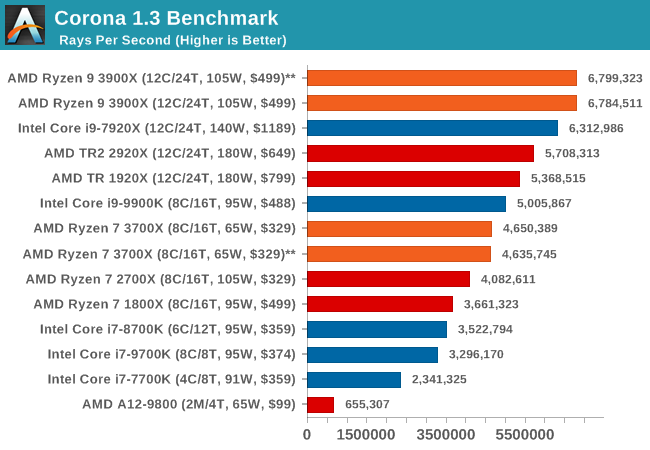
LuxMark v3.1: LuxRender via Different Code Paths
As stated at the top, there are many different ways to process rendering data: CPU, GPU, Accelerator, and others. On top of that, there are many frameworks and APIs in which to program, depending on how the software will be used. LuxMark, a benchmark developed using the LuxRender engine, offers several different scenes and APIs.

Taken from the Linux Version of LuxMark
In our test, we run the simple ‘Ball’ scene on both the C++ and OpenCL code paths, but in CPU mode. This scene starts with a rough render and slowly improves the quality over two minutes, giving a final result in what is essentially an average ‘kilorays per second’.

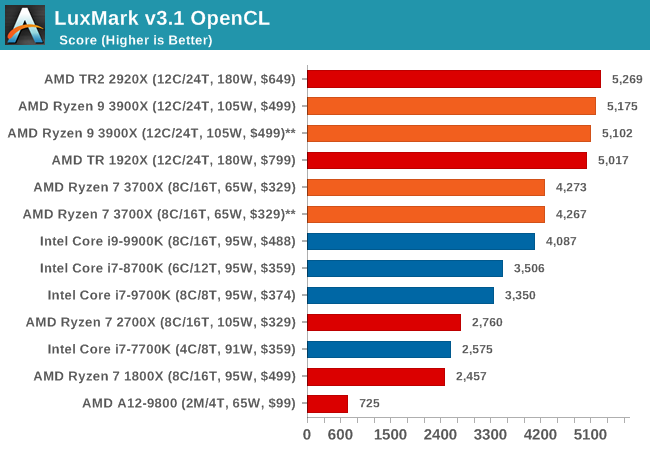
POV-Ray 3.7.1: Ray Tracing
The Persistence of Vision ray tracing engine is another well-known benchmarking tool, which was in a state of relative hibernation until AMD released its Zen processors, to which suddenly both Intel and AMD were submitting code to the main branch of the open source project. For our test, we use the built-in benchmark for all-cores, called from the command line.
POV-Ray can be downloaded from http://www.povray.org/
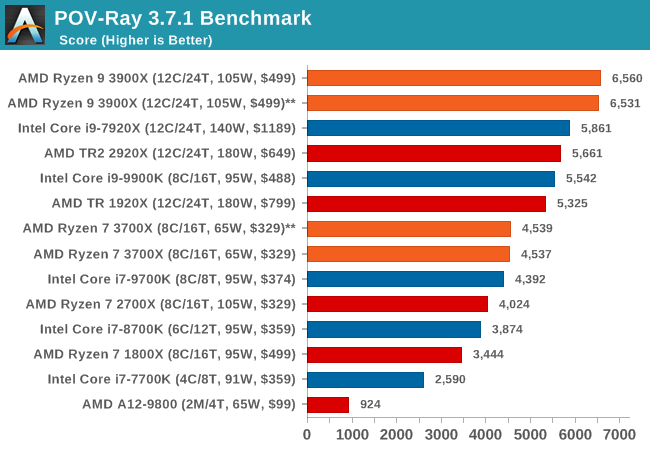
Cinebench R15
The latest version of CineBench has also become one of those 'used everywhere' benchmarks, particularly as an indicator of single thread performance. High IPC and high frequency gives performance in ST, whereas having good scaling and many cores is where the MT test wins out.
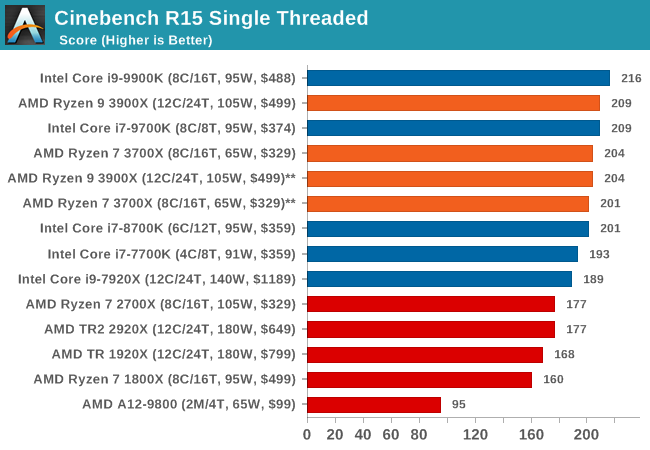
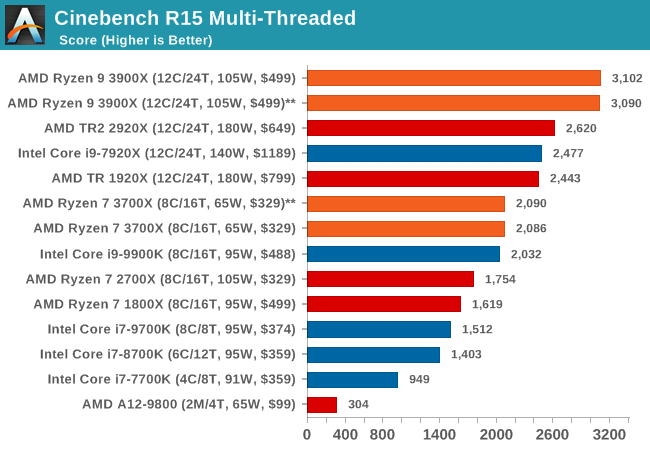











447 Comments
View All Comments
beginning - Thursday, July 11, 2019 - link
I noticed that at the E3 2019 tech day, AMD recommended DDR4-3600 CL16 RAM. I see that 3200 MHz RAM has been used in the AMD testbench. I read the description about avoiding overclocking but 3600 MHz RAMs come with a factory clock of 3600 MHz, right? I know I am missing something. What am I missing?sknaumov - Thursday, July 11, 2019 - link
Do you plan to make some tests of these CPUs on older, cheaper and colder motherboards? It would be very interesting to see results of b450 chipset and whether it is possible to use DDR4-3600MHz with tight timings on these older boards. Or at least provide more info about what has more priority for memory speed and timings on AMD platform - CPU or chipset.viperswhip - Thursday, July 11, 2019 - link
I am going to wait to build a PC for a bit, however, I am super excited by this launch and disappointed by the video card launch. I expect to have an AMD chip since Intel has no answer for this, and we shall see on the video cards, but if I was building today I'd probably get a 2070 RTX super.PProchnow - Friday, July 12, 2019 - link
Here's is Jus' a good ol' boy trying out. No OC off stock Multi but 3333Mhz RAM#1
https://browser.geekbench.com/v4/cpu/13863634
Rather a new rig and it is X470 up to the A.A BIOS and it is MSI Gaming Plus.
OK link #2 is here and I stroked the DDR$ up top 3333Mhz. I also stroked the fan
to stay sub 70C. Wild OCs will take water at least "in The Home" versus LiqN2 Lab.
https://browser.geekbench.com/v4/cpu/13865361
BTW where is the Bragging Thread? My MOBO is the MSI X470 Gaming Plus BIOS A.A makes Ryzen 9 go BTW.
I have yet to up the MULTI in case you want to know. I wonder what good Ocers will get with the right stuff.
Single-Core Performance
Memory Score 6431
Floating Point Score 5409
Integer Score 5190
Crypto Score 6888
Single-Core Score 5589
You underst and that RAM set at 1672 is 1/2 the common referred to speed. 3344Mhz is the common nomenclature.
***Single-Core Score ***Multi-Core Score
5589 47755
Geekbench 4.3.4 Tryout for Windows x86 (64-bit)
Result Information
Upload Date July 12 2019 08:16 PM
Views 2
System Information
System Information
Operating System Microsoft Windows 10 Pro (64-bit)
Model Micro-Star International Co., Ltd. MS-7B79
Motherboard Micro-Star International Co., Ltd. X470 GAMING PLUS (MS-7B79)
Memory 32768 MB DDR4 SDRAM 1672MHz
Northbridge AMD Ryzen SOC 00
Southbridge AMD X470 51
BIOS American Megatrends Inc. A.A0
Processor Information
Name AMD Ryzen 9 3900X
Topology 1 Processor, 12 Cores, 24 Threads
Identifier AuthenticAMD Family 23 Model 113 Stepping 0
Base Frequency 3.80 GHz
Maximum Frequency 4.53 GHz
Maxiking - Tuesday, July 23, 2019 - link
Why would anyone brag about something ifYou can't reach 5.0ghz +
You can't reach even the boost frequency on a single core
You can't beat consistently competitor's older 14nm cpu architecture which has been on the market since 2016...
You can't beat RAM OC'ing records either because over 3733mhz IF gets actually downlocked and due tu that, "faster" ram performs worse unless you OC 7400mhz, which is not possible even with liquid nitrogen.
PProchnow - Friday, July 12, 2019 - link
These are my scores with my Ryzen 9 3900X.#1
https://browser.geekbench.com/v4/cpu/13863634
Rather a new rig and it is X470 up to the A.A BIOS and it is MSI Gaming Plus.
OK link #2 is here and I stroked the DDR$ up top 3333Mhz. I also stroked the fan
to stay sub 70C. Wild OCs will take water at least "in The Home" versus LiqN2 Lab.
https://browser.geekbench.com/v4/cpu/13865361
BTW where is the Bragging Thread? My MOBO is the MSI X470 Gaming Plus BIOS A.A makes Ryzen 9 go BTW.
I have yet to up the MULTI in case you want to know. I wonder what good Ocers will get with the right stuff.
Single-Core Performance
Memory Score 6431
Floating Point Score 5409
Integer Score 5190
Crypto Score 6888
Single-Core Score 5589
You underst and that RAM set at 1672 is 1/2 the common referred to speed. 3344Mhz is the common nomenclature.
***Single-Core Score ***Multi-Core Score
5589 47755
Geekbench 4.3.4 Tryout for Windows x86 (64-bit)
Result Information
Upload Date July 12 2019 08:16 PM
Views 2
System Information
System Information
Operating System Microsoft Windows 10 Pro (64-bit)
Model Micro-Star International Co., Ltd. MS-7B79
Motherboard Micro-Star International Co., Ltd. X470 GAMING PLUS (MS-7B79)
Memory 32768 MB DDR4 SDRAM 1672MHz
Northbridge AMD Ryzen SOC 00
Southbridge AMD X470 51
BIOS American Megatrends Inc. A.A0
Processor Information
Name AMD Ryzen 9 3900X
Topology 1 Processor, 12 Cores, 24 Threads
Identifier AuthenticAMD Family 23 Model 113 Stepping 0
Base Frequency 3.80 GHz
Maximum Frequency 4.53 GHz
Now you can cross ref with others.
Meteor2 - Monday, July 15, 2019 - link
Nice!willis936 - Wednesday, July 17, 2019 - link
The editor's choice awards are a bit strange to me. Zen 1 didn't receive one even though it was the largest CPU performance increase from a company this century. The i7-4950HQ received an editor's choice silver award even though it had little importance to the industry. And the 3700X, which offers comparable SP performance to competing intel products at a huge discount and smaller power budget gets the same editor's choice level as the i7-4950HQ?willis936 - Wednesday, July 17, 2019 - link
I know it was a different editor at the time, but the selective excitement is a bit of a bummer. eDRAM was exciting to see at the time and then nothing ever came of it. The enthusiasm of chiplets under the new editor comes through much less. That too is fine. However if the rating system is what it is then I don't think it's much to argue that chiplets are much more disruptive than eDRAM and is already making much larger waves.Maxiking - Monday, July 22, 2019 - link
AMD fraund getting finally the attention it deserveshttps://www.youtube.com/watch?v=x03FyPQ3a3E
check at 05m25s